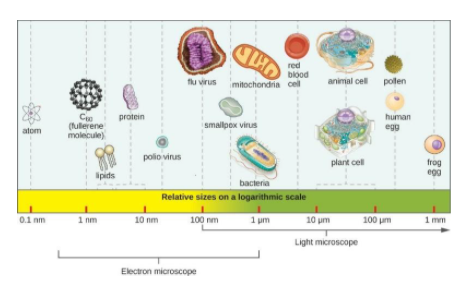
Write the smallest and largest sizes of bacteria?
Answer
572.4k+ views
Hint: Bacteria are single-celled and are classified under the domain Prokaryota. As such, they lack membrane-bound organelles like those found in eukaryotes.
Although they are all microscopic organisms that can be found in various environments in nature, bacteria widely vary in size, shape, and arrangement.
Complete answer: 1. Bacteria are between 0.2 and 2.0 um – the average size of most bacteria. Research studies have shown their size to play an important role in survival over time. Due to their small size, bacteria are able to exploit and thrive in various microenvironments.

2. These include such environments as the vertical gradients in intertidal marine sediments in which various types of bacteria have been found.
3. The small size of bacteria is also beneficial for parasitism and oligotrophy.
Bacteria can continue relying on a range of hosts (large and small) for their nutrition.
4. Some of the smallest bacteria are microorganisms known as nanobacterium.
They are characterized by their slow growth under aerobic conditions as well as being Gram-negative in nature.
5. Although they have been shown to range between 0.2 and 0.5um (200 to 500 nanometers) there have been studies where some were found to filter through 0.1um filters.
Some bacteria are large enough to see with the naked eye.
6. For instance, whereas Schaudinnum bütschlii that measure between 4 and 5um in diameter are considered to be large bacteria.
7. Thiomargarita namibiensis may grow to be as large as 0.75mm in diameter.
This makes them some of the largest bacteria ever discovered.
Note: Pelagibacter ubique is one of the smallest known free-living bacteria, with a length of 370 to 890 nm and an average cell diameter of 120 to 200 nm.
They also have the smallest free-living bacterium genome: 1.3 Mbp, 1354 protein genes, 35 RNA genes.
Although they are all microscopic organisms that can be found in various environments in nature, bacteria widely vary in size, shape, and arrangement.
Complete answer: 1. Bacteria are between 0.2 and 2.0 um – the average size of most bacteria. Research studies have shown their size to play an important role in survival over time. Due to their small size, bacteria are able to exploit and thrive in various microenvironments.

2. These include such environments as the vertical gradients in intertidal marine sediments in which various types of bacteria have been found.
3. The small size of bacteria is also beneficial for parasitism and oligotrophy.
Bacteria can continue relying on a range of hosts (large and small) for their nutrition.
4. Some of the smallest bacteria are microorganisms known as nanobacterium.
They are characterized by their slow growth under aerobic conditions as well as being Gram-negative in nature.
5. Although they have been shown to range between 0.2 and 0.5um (200 to 500 nanometers) there have been studies where some were found to filter through 0.1um filters.
Some bacteria are large enough to see with the naked eye.
6. For instance, whereas Schaudinnum bütschlii that measure between 4 and 5um in diameter are considered to be large bacteria.
7. Thiomargarita namibiensis may grow to be as large as 0.75mm in diameter.
This makes them some of the largest bacteria ever discovered.
Note: Pelagibacter ubique is one of the smallest known free-living bacteria, with a length of 370 to 890 nm and an average cell diameter of 120 to 200 nm.
They also have the smallest free-living bacterium genome: 1.3 Mbp, 1354 protein genes, 35 RNA genes.
Recently Updated Pages
Master Class 12 Economics: Engaging Questions & Answers for Success

Master Class 12 Maths: Engaging Questions & Answers for Success

Master Class 12 Biology: Engaging Questions & Answers for Success

Master Class 12 Physics: Engaging Questions & Answers for Success

Master Class 8 Maths: Engaging Questions & Answers for Success

Class 8 Question and Answer - Your Ultimate Solutions Guide

Trending doubts
What is meant by exothermic and endothermic reactions class 11 chemistry CBSE

10 examples of friction in our daily life

One Metric ton is equal to kg A 10000 B 1000 C 100 class 11 physics CBSE

1 Quintal is equal to a 110 kg b 10 kg c 100kg d 1000 class 11 physics CBSE

Difference Between Prokaryotic Cells and Eukaryotic Cells

What are Quantum numbers Explain the quantum number class 11 chemistry CBSE




